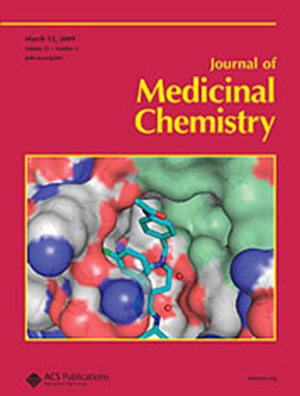Discovery of 2-Pyrazolylpyrimidinone Derivatives as New SPOP Inhibitors for Renal Cell Carcinoma Therapy.
IF 6.8
1区 医学
Q1 CHEMISTRY, MEDICINAL
引用次数: 0
Abstract
E3 ligase speckle-type POZ protein (SPOP) is a potential therapeutic target in clear-cell renal cell carcinoma (ccRCC). However, small-molecule inhibitors targeting SPOP are rarely reported. Here, we identified DDO-4033 as a potent SPOP inhibitor through virtual screening and optimization. This 2-pyrazolylpyrimidinone derivative exhibited potent affinity with SPOP in vitro and efficiently impeded the malignant migration, invasion, and proliferation of ccRCC cell lines. DDO-4033 disrupted the SPOP recruitment of substrate LATS1 and inhibited the polyubiquitination and subsequent degradation, resulting in the upregulation of tumor suppressor LATS1. The increased abundance of LATS1 inactivated the transcriptional factors YAP1 and WWTR1/TAZ, ultimately turning on the Hippo signaling pathway in kidney cancer cells. Our findings identify DDO-4033 as a new SPOP-targeted inhibitor with decent antitumor activity, providing a potential lead for the development of ccRCC therapy.2-吡唑基嘧啶衍生物作为肾细胞癌治疗新的SPOP抑制剂的发现。
E3连接酶斑点型POZ蛋白(SPOP)是透明细胞肾细胞癌(ccRCC)的潜在治疗靶点。然而,针对SPOP的小分子抑制剂鲜有报道。在这里,我们通过虚拟筛选和优化确定了DDO-4033是一种有效的SPOP抑制剂。该2-吡唑基嘧啶酮衍生物在体外表现出与SPOP的强亲和力,并能有效地抑制ccRCC细胞系的恶性迁移、侵袭和增殖。DDO-4033破坏了底物LATS1的SPOP募集,抑制了多泛素化和随后的降解,导致肿瘤抑制因子LATS1上调。LATS1丰度的增加使转录因子YAP1和WWTR1/TAZ失活,最终开启肾癌细胞中的Hippo信号通路。我们的研究结果表明,DDO-4033是一种新的spop靶向抑制剂,具有良好的抗肿瘤活性,为ccRCC治疗的发展提供了潜在的先导。
本文章由计算机程序翻译,如有差异,请以英文原文为准。
求助全文
约1分钟内获得全文
求助全文
来源期刊

Journal of Medicinal Chemistry
医学-医药化学
CiteScore
4.00
自引率
11.00%
发文量
804
审稿时长
1.9 months
期刊介绍:
The Journal of Medicinal Chemistry is a prestigious biweekly peer-reviewed publication that focuses on the multifaceted field of medicinal chemistry. Since its inception in 1959 as the Journal of Medicinal and Pharmaceutical Chemistry, it has evolved to become a cornerstone in the dissemination of research findings related to the design, synthesis, and development of therapeutic agents.
The Journal of Medicinal Chemistry is recognized for its significant impact in the scientific community, as evidenced by its 2022 impact factor of 7.3. This metric reflects the journal's influence and the importance of its content in shaping the future of drug discovery and development. The journal serves as a vital resource for chemists, pharmacologists, and other researchers interested in the molecular mechanisms of drug action and the optimization of therapeutic compounds.
 求助内容:
求助内容: 应助结果提醒方式:
应助结果提醒方式:


